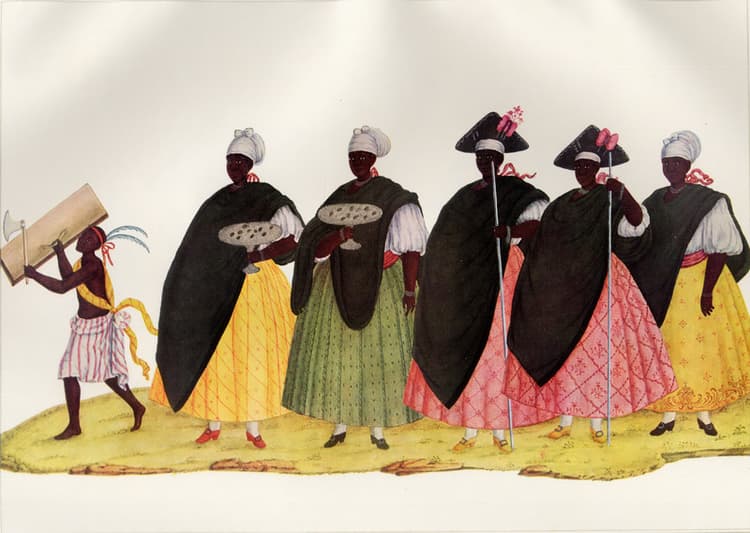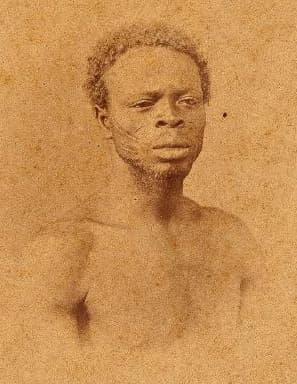Diasporic Connections: Slavery and Freedom in Brazil
Ryan Lee
10 min read
Listen to this study note
Study Guide Overview
This study guide compares and contrasts slavery in Brazil and the United States, covering the scale of enslavement, cultural preservation, manumission, and population shifts. It analyzes visual sources like images of Capoeira, Escravo Mina, and the Festival of Our Lady of the Rosary to understand the lived experiences of enslaved Africans. Finally, it provides practice questions and exam tips for the AP African American Studies exam.
#AP African American Studies: Brazil & The United States - A Comparative Study Guide 🇧🇷🇺🇸
Hey there! Let's get you prepped for the AP exam with a deep dive into the differences between slavery in Brazil and the US. This guide is designed to be your go-to resource, especially the night before the exam. Let's make sure you're feeling confident and ready to ace it! 💪
#Enslavement in Brazil: Scale, Culture, and Shifts
#Scale of African Enslavement 🌍
- Massive Influx: Brazil received the largest number of enslaved Africans in the Americas, with approximately 5 million people landing on its shores. That's half of the 10 million who survived the brutal Middle Passage! 🤯
- Diverse Labor: Enslaved Africans were forced into various labor roles that evolved over time:
- Sugar plantations 🍬
- Gold mines ⛏️
- Coffee plantations ☕
- Cattle ranching 🐄
- Production of food and textiles for domestic consumption 🧺
#Preservation of African Culture 🎭
- Cultural Hubs: The sheer number of African-born individuals in Brazil led to the formation of communities that maintained and preserved their cultural heritage.
- Enduring Traditions: Some of these African cultural practices still thrive in Brazil today:
- Capoeira: A martial art developed by enslaved Africans, combining music, dance, and call-and-response singing. 🤸🏾u200d♂️
- Congada: A celebration honoring the King of Kongo and Our Lady of the Rosary. 👑
- Key Reason: The large number of enslaved Africans allowed them to maintain their traditions and pass them down through generations. 💡
#Shifts in Enslaved Populations 📉
- Brazil's Decline: Throughout the 19th century, the number of enslaved Africans in Brazil gradually decreased, while the free Black population grew significantly.
- Manumission: This shift was primarily due to the increased frequency of manumission (release from slavery) in Brazil. 📜
- Iberian & Catholic Influence: Influenced by Iberian laws and the Catholic Church, which encouraged the freeing of enslaved individuals.
- Pre-Abolition Freedom: By the time Brazil abolished slavery in 1888, around 4 million people of African ancestry were already free. 🥳
- 1888 Abolition: The abolition of slavery in Brazil in 1888 freed the remaining 1.5 million Africans who were still enslaved. 🎉
#Contrasting Trajectories: Brazil vs. The United States 🔄
#US's Increasing Enslaved Population 📈
- Continued Growth: In contrast to Brazil, the number of enslaved Africans in the United States continued to rise throughout the 19th century, despite the 1808 ban on importing enslaved Africans. 🚫
- Birth into Slavery: This increase was primarily due to the children of enslaved people being born into enslavement themselves, perpetuating the institution. 👶🏾
- Emancipation: By the time of the Emancipation Proclamation, which declared the freedom of enslaved people in the Confederate states during the American Civil War, approximately 4 million Africans remained enslaved in the United States. 😔
- Scale of Enslavement: This accounted for about 50 percent of all enslaved people in the Americas at that time. 📊
- Key Takeaway: The different trajectories of enslaved populations in Brazil and the United States highlight the varying ways in which slavery evolved and was maintained in different parts of the Americas. 🧐
Remember, AP questions often ask you to compare and contrast. Understanding these different trajectories is crucial!
#Required Sources: Visualizing History
#Festival of Our Lady of the Rosary, Rio de Janeiro, Brazil by Carlos Julião, Circa 1770s

- Visual Depiction: This 18th-century artwork provides a rare visual depiction of Afro-Brazilian religious and cultural practices during the colonial period.
- Cultural Insights: It offers valuable insights into how enslaved Africans and their descendants maintained and adapted their traditions in the New World, blending African spirituality with Catholic elements.
- Social Dynamics: The piece illuminates the complex racial and social dynamics of colonial Brazil, showcasing the interactions between different ethnic groups.
- Historical Record: It serves as a crucial historical record, demonstrating the resilience and creativity of African diaspora communities in preserving their heritage while navigating the oppressive conditions of slavery.
#Escravo Mina and Escrava Mina by José Christiano de Freitas Henriques Junior, 1864


- Rare Glimpse: These photographs provide a rare glimpse into the lives of enslaved Africans in 19th-century Brazil, specifically those from the Mina Coast region.
- Visual Evidence: It captures the physical appearance, dress, and demeanor of an individual subjected to the brutal institution of slavery, offering valuable visual evidence for researchers and students of African diaspora history.
- Human Cost: The images serve as a poignant reminder of the human cost of the transatlantic slave trade and its lasting impact on Brazilian society.
- Legacy: It challenges viewers to confront the realities of slavery and consider its legacy in shaping racial dynamics, cultural practices, and socioeconomic structures in Brazil and throughout the Americas.
#Capoeira Players and Musicians on Beach in Salvador da Bahia

- Cultural Fusion: Capoeira represents a unique fusion of African cultural traditions that survived and evolved in Brazil despite the brutality of slavery.
- Resistance: This Afro-Brazilian martial art disguised as dance embodies resistance, preserving elements of West African fighting techniques, music, and spirituality under the guise of harmless entertainment.
- Cultural Reclamation: The practice of capoeira in Salvador da Bahia, a center of Afro-Brazilian culture, demonstrates the resilience and creativity of the African diaspora.
- Enduring Legacy: Its continued performance on the beaches where enslaved Africans once arrived symbolizes cultural reclamation and the enduring legacy of African contributions to Brazilian society and identity.
Remember "B-M-U" (Brazil-Manumission-US) to recall the different trends in enslaved populations. Brazil saw manumission increase while the US's enslaved population continued to rise.
#Key Points to Remember
- Scale Matters: Brazil received the largest number of enslaved Africans, which significantly impacted the preservation of African culture.
- Manumission: The practice of manumission in Brazil led to a growing free Black population, contrasting with the US.
- Visual Sources: The provided images are crucial for understanding the lived experiences of enslaved Africans and the cultural expressions of the African diaspora.
#Final Exam Focus 🎯
- Highest Priority Topics:
- The scale of the transatlantic slave trade and its impact on different regions.
- The various forms of resistance to slavery, including cultural preservation.
- The differing trajectories of enslaved populations in Brazil and the US.
- The legacy of slavery and its continuing impact on society.
- Common Question Types:
- Multiple-choice questions that test factual knowledge and analytical skills.
- Short-answer questions that require you to synthesize information and provide concise explanations.
- Free-response questions that ask you to analyze complex historical developments and evaluate different perspectives.
- Last-Minute Tips:
- Time Management: Allocate your time wisely, and don't spend too long on any one question.
- Common Pitfalls: Avoid making generalizations or oversimplifications. Always provide evidence to support your claims.
- Strategies: Read the questions carefully and make sure you understand what is being asked. Use the provided sources to support your answers.
Remember to connect different units! AP questions often combine multiple concepts. For example, you might see a question that asks you to compare the impact of slavery on cultural development in Brazil and the US.
Practice Question
#Practice Questions
#Multiple Choice Questions
-
Which of the following best explains why African cultural practices were more preserved in Brazil than in the United States? a) Brazil had a smaller enslaved population, allowing for closer-knit communities. b) Brazil received a larger number of enslaved Africans, leading to the formation of communities that could maintain their traditions. c) The Catholic Church in Brazil actively promoted the preservation of African culture. d) Enslaved Africans in the US were more quickly assimilated into European culture.
-
What was a primary reason for the decline in the enslaved population in Brazil during the 19th century? a) A successful large-scale rebellion of enslaved people. b) The implementation of strict anti-slavery laws. c) The increased frequency of manumission. d) A decrease in the birth rate of enslaved people.
-
The photographs of the "Escravo Mina" and "Escrava Mina" primarily serve as: a) Evidence of the comfortable living conditions of enslaved people. b) A visual record of the physical appearance and dress of enslaved people. c) A demonstration of the diversity of African cultures in Brazil. d) A celebration of the end of slavery in Brazil.
#Free Response Question
Question: Analyze the differences in the trajectories of enslaved populations in Brazil and the United States during the 19th century. In your response, consider the factors that contributed to these differences and the impact on the respective societies. Use the provided sources to support your analysis.
Scoring Breakdown:
- Thesis (1 point): A clear, historically defensible thesis that addresses the prompt.
- Evidence (2 points): Uses evidence from the provided sources to support the argument. (1 point for each source)
- Analysis (2 points): Explains the factors that contributed to the different trajectories of enslaved populations in Brazil and the US. (1 point for each country)
- Synthesis (1 point): Connects the analysis to a broader understanding of the impact of slavery on the respective societies.
Sample Answer:
- Thesis: While both Brazil and the United States relied on enslaved labor, their trajectories differed significantly during the 19th century. Brazil saw a decline in its enslaved population due to manumission, while the US experienced a continued increase due to birth into slavery. This divergence had lasting impacts on the social and cultural landscapes of both nations.
- Evidence: The source "Festival of Our Lady of the Rosary" illustrates the blending of African and Catholic traditions in Brazil, suggesting a more integrated society. The photographs of "Escravo Mina" and "Escrava Mina" provide a visual representation of the enslaved individuals in Brazil, highlighting the human cost of slavery. The capoeira image shows cultural resistance and preservation.
- Analysis: In Brazil, Iberian laws and the Catholic Church encouraged manumission, leading to a growing free Black population. In contrast, the US saw a rise in its enslaved population due to children being born into slavery, despite the ban on importing enslaved Africans. This difference is crucial for understanding the different social dynamics of the two regions.
- Synthesis: The differing trajectories of enslaved populations in Brazil and the US had significant long-term consequences. Brazil’s larger free Black population contributed to a more diverse cultural landscape, while the US faced a more entrenched system of racial inequality.
Good luck, you've got this! 🚀 Remember, you're not just memorizing facts; you're uncovering the stories of the past. Go get 'em! 🎉
Continue your learning journey

How are we doing?
Give us your feedback and let us know how we can improve





